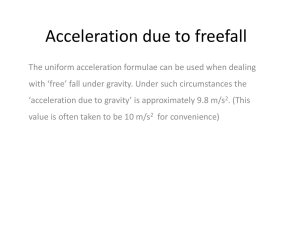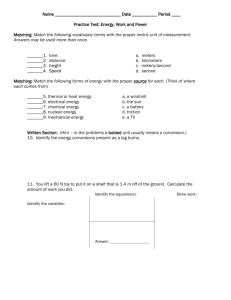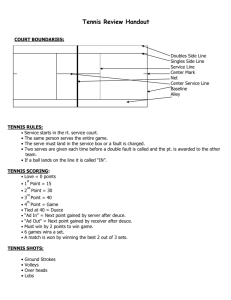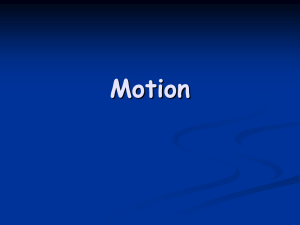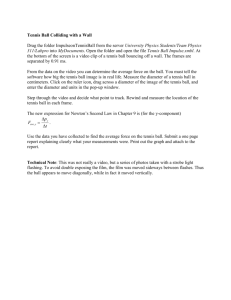Vertical motion: the stationary tennis ball
advertisement
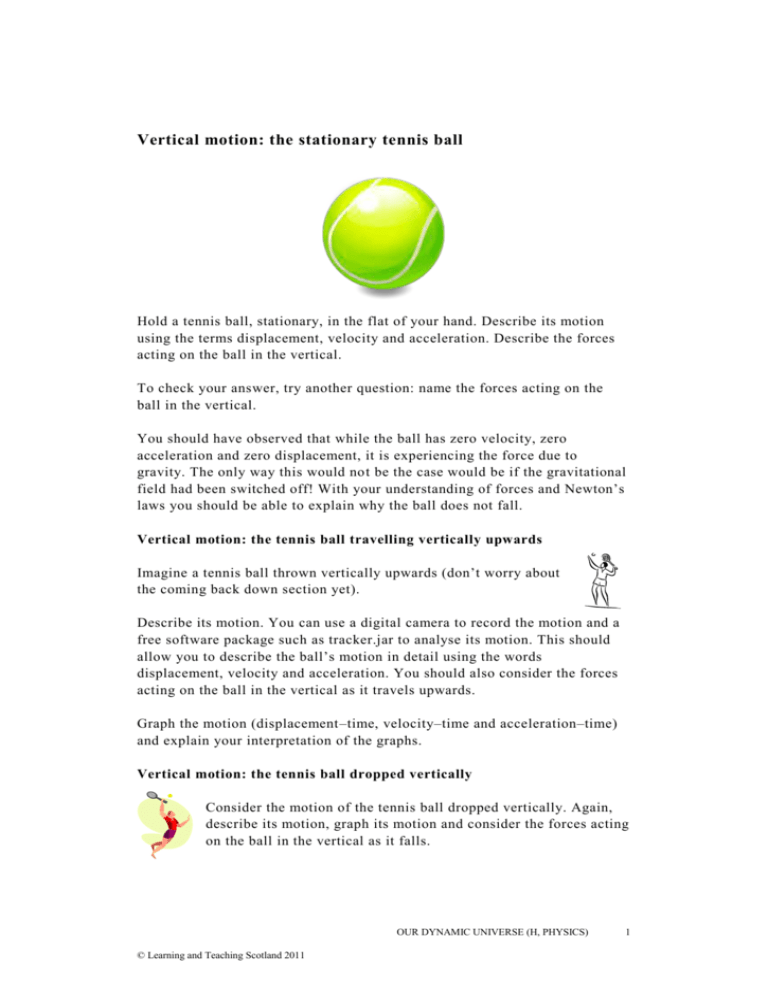
Vertical motion: the stationary tennis ball Hold a tennis ball, stationary, in the flat of your hand. Describe its motion using the terms displacement, velocity and acceleration. Describe the forces acting on the ball in the vertical. To check your answer, try another question: name the forces acting on the ball in the vertical. You should have observed that while the ball has zero velocity, zero acceleration and zero displacement, it is experiencing the force due to gravity. The only way this would not be the case would be if the gravitational field had been switched off! With your understanding of forces and Newton’s laws you should be able to explain why the ball does not fall. Vertical motion: the tennis ball travelling vertically upwards Imagine a tennis ball thrown vertically upwards (don’t worry about the coming back down section yet). Describe its motion. You can use a digital camera to record the motion and a free software package such as tracker.jar to analyse its motion. This should allow you to describe the ball’s motion in detail using the words displacement, velocity and acceleration. You should also consider the forces acting on the ball in the vertical as it travels upwards. Graph the motion (displacement–time, velocity–time and acceleration–time) and explain your interpretation of the graphs. Vertical motion: the tennis ball dropped vertically Consider the motion of the tennis ball dropped vertically. Again, describe its motion, graph its motion and consider the forces acting on the ball in the vertical as it falls. OUR DYNAMIC UNIVERSE (H, PHYSICS) © Learning and Teaching Scotland 2011 1 Vertical motion: prediction Consider two tennis balls, one filled with a fluid such as water, but otherwise identical. Both are dropped from the same height. Which one hits the ground first? Explain your answer in terms of forces and acceleration. Vertical motion: freefall (or which falls faster, the hammer or the feather?) Consider the image opposite. What does the spacing between the feathers tell you about its motion? Under what circumstances could this photograph have been taken? The Apollo 15 hammer–feather drop At the end of the last Apollo 15 moon walk, Commander David Scott…performed a live demonstration for the television cameras. He held out a geologic hammer and a feather and dropped them at the same time. Because they were essentially in a vacuum, there was no air resistance and the feather fell at the same rate as the hammer, as Galileo had concluded hundreds of years before – all objects released together fall at the same rate regardless of mass. Mission controller Joe Allen described the demonstration in the Apollo 15 Preliminary Science Report: ‘During the final minutes of the third extravehicular activity, a short demonstration experiment was conducted. A heavy object (a 1.32 -kg aluminum geological hammer) and a light object (a 0.03 -kg falcon feather) were released simultaneously from approximately the same height (approximately 1.6 m) and were allowed to fall to the surface. Within the accuracy of the simultaneous release, the objects were obser ved to undergo the same acceleration and strike the lunar surface simultaneously, which was a result predicted by well-established theory, but a result nonetheless reassuring considering both the number of viewers that witnessed the experiment and the fact that the homeward journey was based critically on the validity of the particular theory being tested.’ 2 OUR DYNAMIC UNIVERSE (H, PHYSICS) © Learning and Teaching Scotland 2011 Joe Allen, NASA SP-289, Apollo 15 Preliminary Science Report, Summary of Scientific Results, p. 2–11. The video of this experiment can be seen at http://nssdc.gsfc.nasa.gov/planetary/lunar/apollo_15_feather_drop.html. The phrase ‘all objects released together fall at the same rate, regardless of mass’ is a very important one. Of course, this applies only in the absence of air resistance, which is why the moon is a good place to choose! Galileo (1564–1642) (see http://www.bbc.co.uk/history/historic_figures/galilei_galileo.shtml) had theorised about this. Whether or not he actually carried out experiments involving cannonballs being dropped from the Leaning Tower of Pisa, however, is unknown. Galileo’s approach to science was significant in that he used mathematics to analyse the results of his experiments. Like Newton (1642 – 1727) and Einstein (1879–1955), Galileo used ‘thought’ experiments: experiments carried out entirely in the mind using reasoning and logic to help explain complex ideas. OUR DYNAMIC UNIVERSE (H, PHYSICS) © Learning and Teaching Scotland 2011 3 Calculating Weight A planet’s gravitational field strength equals the force of gravity per unit mass. The equation linking weight, mass and gravity is: W = mg w = weight in newtons (N) m = mass in kilograms (kg) g = gravitational field strength in newtons per kilogram (N kg –1 ) Near the surface of a planet, all objects experience the same acceleration a due to the force of gravity. On Earth: g = 9.8 N kg –1 a = 9.8 m s –2 Consider: Is the gravitational field strength the same on each planet? How does distance affect gravitational field strength? How will an object’s weight vary as distance from a planet’s surface increases? Gravitational field strength and the force due to gravity will be examined more closely later on within this unit. Vertical motion: the tennis ball 1. Dropped vertically and allowed to bounce. 2. Thrown vertically upwards and allowed to fall back to its starting position. Using your understanding of vertical motion, you should now be able to describe, explain and sketch graphs of motion for a tennis ball dropped vertically and allowed to bounce until it comes to rest, and for a ball thrown vertically upwards and allowed to fall back to its starting position. 4 OUR DYNAMIC UNIVERSE (H, PHYSICS) © Learning and Teaching Scotland 2011 Using the equations of motion for vertical motion Estimate the initial acceleration of a jumping popper. Calculate the initial acceleration of the jumping popper. What assumptions are you making? How could your calculation be improved? OUR DYNAMIC UNIVERSE (H, PHYSICS) © Learning and Teaching Scotland 2011 5
